Visit Patagonia
Desert, but full of ice. Distant, but full of life. Rugged, but beautiful. Harsh, but irresistible. All this can be said about the magnificent region of Patagonia.
Patagonia is a vast region at the southern tip of the South American continent. The region is divided between Argentina and Chile.
The borders of Patagonia are often contested and debated. However, some general rules of thumb can be applied when it comes to Patagonian boundaries. The Andes mountain range creates a natural border between western or Chilean and eastern or Argentine Patagonia. On the west, Patagonia is bounded by the Andes, fjords and the Pacific ocean. On the east, the Patagonian desert goes all the way to the Atlantic. In the south, Patagonia stretches to the Tierra del Fuego and Cape Horn, the southernmost point of South America. In the north boundaries of Patagonia are not so clear. Most of the time, it is said that the town of Temuco is on the northern edge of Chilean Patagonia. Argentine Patagonia extends further up north to the Colorado River.
Below you will find the guide for visiting Patagonia. We will explain ways of reaching Patagonia, describe the weather, list some of the best sights to visit and activities to do, what to eat and where to sleep. In the end, we will also mention some fun facts and give you a map of all the places we have mentioned. Without further ado, let’s begin.
Table of Contents
How to get to Patagonia
Flying is the most time-efficient and convenient way to reach Patagonia. To get to Patagonia from outside of South America, you are most likely going to fly into Santiago or Buenos Aires Airports.
While booking your flights have in mind that domestic flights are much cheaper than cross-country flights. For this reason, if you are heading to the Chilean side of Patagonia fly into Santiago. And if you are going to the Argentine side of Patagonia fly into Buenos Aires.
From Santiago and Buenos Aires, you can take domestic flights to the smaller Patagonian towns. On the Chilean side, people usually fly either to Puerto Montt* in northern Patagonia or to Punta Arenas in southern Patagonia. Other often-used airports in Chilean Patagonia are Punta Natales and Balmaceda.
On the Argentine side, people usually fly either to Bariloche in northern Patagonia or to Ushuaia in southern Patagonia. Other often-used airports in Argentine Patagonia are El Calafate and Rio Gallegos.
List of all airports you can fly to in Chile and Argentina.

How to move around Patagonia
Patagonia is huge and remote, which means that moving around Patagonia will take some planning. It is impossible to pick the best transportation option because it depends on your location, destination, budget and schedule. For this reason, we recommend doing research and taking the time to prepare your itinerary.
However, we have made an overview of transportation options in Patagonia for you.
Bus
Travelling by bus is the cheapest way of moving around Patagonia. Most of the time, buses are comfortable and spacious. However, Patagonia is huge and travelling by bus can take up a lot of time. Besides this, many bus routes don’t run daily and get sold out quite fast. You will have to be organized and on schedule if you wish to explore the region by bus.
Check this page if you want to know more about bus routes in the region.
Car hire
Renting a car is a great way of exploring Patagonia at your own pace. Many remote areas are tough to reach by bus and having a car is a true blessing. Hiring a car is not as expensive as it used to be. Nowadays, there are many more car rental agencies. If you book online in advance, you could find a great deal and rent a car for the whole month for as low as 1000 USD.
Plane
Flying is the most convenient transportation option in Patagonia. There are many routes you can take from the main airports in Santiago and Buenos Aires. However, flights can be relatively expensive and not all of them are regular. For this reason, we recommend flying only for long distances when driving or taking a bus wouldn’t make sense.
On the Chilean side, people usually fly either to Puerto Montt in northern Patagonia or to Punta Arenas in southern Patagonia.
On the Argentine side, people usually fly either to Bariloche in northern Patagonia or to Ushuaia in Southern Patagonia
Don’t forget that domestic flights are much cheaper than cross-border flights!
Ferry
Taking a ferry ride in Patagonia is not uncommon. Actually, some places are only reachable by boat, and many bus routes include a ferry ride to cut the travelling time shorter. Ferry rides are great if you are not in the rush with time because they are not the fastest transportation option in Patagonia. However, they are arguably the most pleasurable because they offer the incredible experience of sailing through the Patagonian fjords. During the ferry rides, it’s not uncommon to spot animals such as whales, dolphins and penguins.
Weather in Patagonia
If you had to use one word to describe the weather in Patagonia, the word would be unpredictable. Patagonia is huge (over 1 million km²), and the weather reflects that. The climate of Patagonia largely depends on latitude, altitude, and proximity to the sea.
Climate areas
There are a few distinct climate areas within Patagonia, such as the Patagonian desert, Tierra Del Fuego, the Andes and the Patagonian rainforest.
The Patagonian rainforest in the northwest is the area with the most precipitation. The area is strongly influenced by the westerlies that collide with cold air from the Andes, causing a lot of rainfalls. This allows a dense evergreen forest to grow in the area.
In the Andes, you can find a typical alpine climate that is cold and snowy with many permafrost mountain peaks.
The cold Patagonian desert is a dry and windy area with an average temperature of just 3 °C. The area is a part of the so-called arid diagonal in South America, one of the driest regions of the world.

Down south, the Tierra del Fuego has a subpolar oceanic climate with temperatures that rarely surpass 7 °C throughout the year. Summers are cold and wet here which is great for glaciers.
Seasons
In Patagonia, seasons are reversed from what you might be accustomed to because the region is located in the southern hemisphere. It is hard to say what is the best time to visit Patagonia because it depends on your goals and wishes. It would be unfair to pick only one season because each of them offers something unique and worthwhile.
Patagonian summer lasts from December to February. Those are the warmest months, but also the windiest. Days are long, while the temperatures are pleasant and great for activities such as kayaking and horseback riding. Most of the tourists come during the summer months.
Autumn in Patagonia (March, April and May) is particularly photogenic due to the beautiful colours of the trees. Winds are not as strong as they are during the spring or summer, and the area is less crowded with tourists. This creates a great environment for hiking and exploring nature.
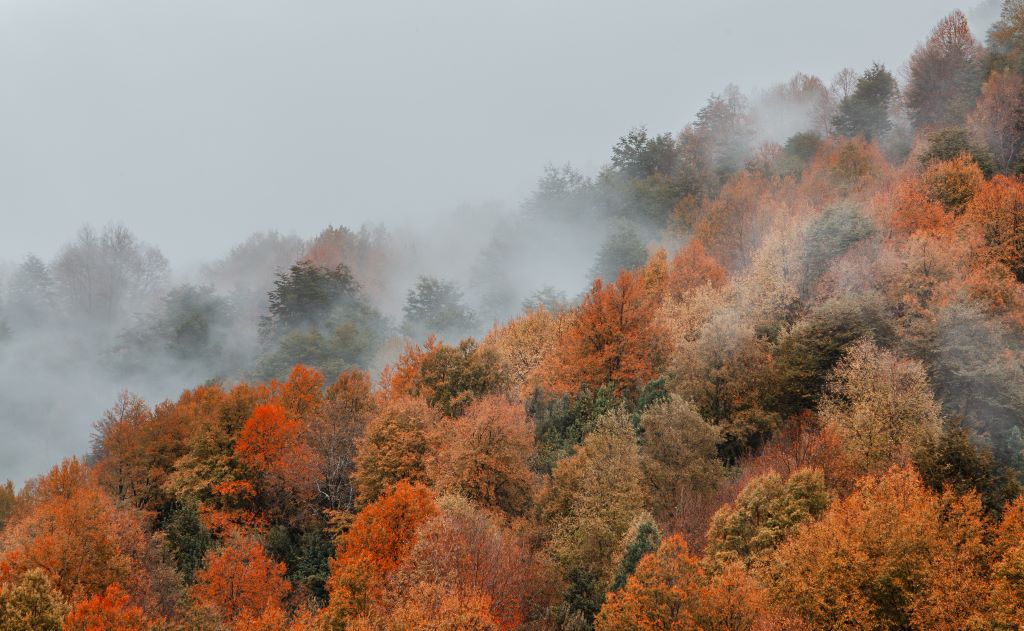
Winter in Patagonia spans from June until the end of August. During these months, the temperatures drop significantly and light snow is common. This is a great time for photographing wildlife such as penguins, pumas and foxes. Even tho some people consider winter the best time for hiking Patagonia, it is not recommended for inexperienced hikers.
Spring lasts from September to November and it is a period during which Patagonia starts to wake up from its winter slumber. Temperatures rise slowly, tourists arrive in larger numbers and trees begin to blossom. This time of year is perfect for fly fishing in the lakes and rivers of Patagonia!
Sights in Patagonia
Patagonia is the land of awe-inspiring scenery and many incredible sights. Its raw natural beauty attracts tourists from all over the world. Have in mind that the Patagonian wilderness is huge and it would be a challenge to see most of it.
For that reason, we have made an overview of the best sights to see in Patagonia.
The Los Glaciares National Park
Los Glaciares is the largest national park in Argentina and one of the most visited areas in Argentine Patagonia. The park is home to numerous glaciers which mostly come from the enormous South Patagonian Ice Field.
Perito Moreno Glacier, named after a famous Argentine explorer, is the most famous glacier in the park. This magnificent wonder of nature lies on top of the large Lake Argentino. The cyclical movement of the glacier creates an astounding sight of huge chunks of ice falling into the lake causing thunderous noise. El Calafate is the closest town to Perito Moreno Glacier and the starting point for excursions towards the glacier. In El Calafate, you can also find an interesting Glaciarium Patagonian Ice Museum.
The other important town in the area is El Chalten. El Chalten is often dubbed the National Capital of Trekking in Argentina. It is located beneath the famous mountain Cerro Chalten, also known as Fitz Roy. Mount Fitz Roy dwells over El Chalten and creates a spectacular view from the valley, while also providing numerous tracking circuits and climbing routes. One really enjoyable route is towards a beautiful Chorrillo Del Salto waterfall.

Torres del Paine National Park
Torres del Paine National Park is just south of Los Glaciares National park, on the Chilean side of the border. This huge park is full of breathtaking scenery of mountains, waterfalls, fjords and glaciers. For this reason, it is one of the premier tourist locations in all of Patagonia.
Torres del Paine is a very popular destination for hikers all around the world because of a wide variety of single and multi-day treks with different difficulties. The most famous hiking circuit is called W–trek. W-Trek takes you to all of the important sights within the park such as the Grey Glacier, French Valley and Lake Sarmiento. However, no sight is more iconic than the Base of the Towers. Three sharp-edged mountain peaks standing above the turquoise lagoon are a sight to remember for the rest of your life.
Don’t be surprised if you see unfamiliar animals while hiking through the Torres del Paine. This national park is home to unique animal species such as Patagonian puma, guanco, armadillo, Huemul deer and many more.
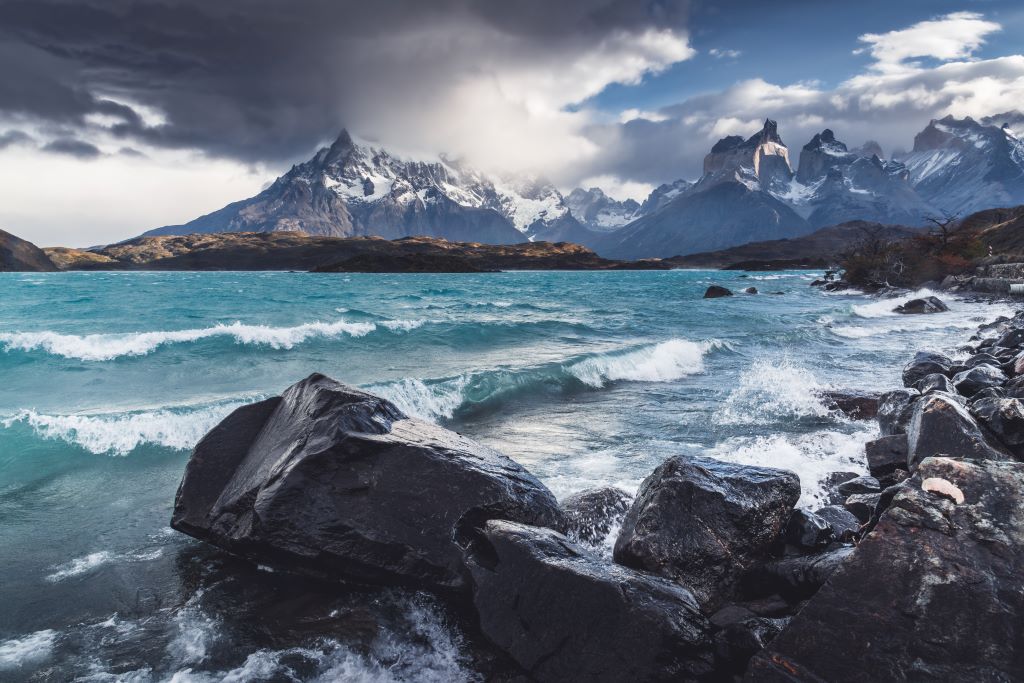
Marble caves
The Marble Caves in Chile, also called the Capillas de Mármol are one of the most extraordinary sights in Patagonia. These magnificent natural wonders are located along the coast of General Carrera Lake, Chiles’ largest lake. Over thousands of years, wind and water have slowly chipped away these marble formations and created fascinating caves and tunnels just above the water level.
Marble Catedral is the most famous marble cave out there. Mesmerizing colours on the walls of the Catedral combined with reflections of a bright blue sea is unlike anything you have ever seen before.
If you wish to visit marble caves, you can take a kayak or boat trip from Puerto Tranquilo.

San Carlos de Bariloche
Located in northern Patagonia, within Argentine Nahuel Huapi national park is the city of San Carlos de Bariloche or just Bariloche as it is often called.
Bariloche is one of the main tourist cities in Patagonia, often referred to as the gateway to Argentine Patagonia because of its airport. It was declared the Argentine Capital of Adventure Tourism in 2012 and the Argentine Capital of Chocolate in 2015. With such titles, it is no surprise that there are plenty of things you can do in Bariloche.
Cerro Catedral Alta Patagonia, one of the most popular skiing resorts in the country is only 20 km from the town.
The city’s centre is full of life, and European style architecture as well. Besides chocolate, the city also has a booming craft beer scene.
However, the main attraction is Nahuel Huapi national park, the oldest national park in Argentina established in 1934. One awesome thing you can do is take the chairlift up the Cerro Campanario. For a fee, you will be rewarded with a remarkable panoramic view of Nahuel Huapi lake, Tronador volcano and surrounding mountains, lakes and glaciers.
Tierra Del Fuego archipelago
On the southernmost point of Patagonia and South America lies the Tierra Del Fuego archipelago. This UNESCO Heritage Site is a true Patagonian gem. “Land of Fire”, as it was named by the Spanish explorers, is one of the most remote places in the world, but it has a lot to offer. Ushuaia is the capital of Tierra del Fuego Province and the world’s southernmost city. It serves as a hub for the exploration of the rest of the archipelago.
Tierra Del Fuego national park is a fantastic place for hiking and enjoying nature full of lakes, glaciers and wildlife. If you had enough hiking, you can kayak through the fjords of the Beagle Channel and Glacier valley. With a kayak, you can reach secluded areas such as the Cordillera Darwin. Along the way, you are more than likely to see Magellanic penguins, sea lions and even whales if you are lucky. Another iconic location you could cruise to from Ushuaia is the famous Cape Horn, which is less than 1000 kilometres from Antarctica.
Museum lovers should visit the Ushuaia Maritime Museum. The museum is situated within the former Ushuaia prison and is divided into a couple of sections. Besides the maritime museum, there is also a prison museum, an Antarctica museum and an art museum.
Cueva de Los Manos
The last sight on our list is a prehistoric artwork site created by our ancient ancestors. Cueva de Los Manos or Cave of the Hands is a UNESCO World Heritage site located in Santa Cruz Province in Argentina. The walls of Cueva de Los Manos are filled with beautiful orange, red and purple hand paintings dating back to more than 9000 BC. There are two main theories surrounding the handprints in the cave. The first one is that handprints are a part of an initiation ceremony for adolescent boys. The other claims that they are a part of a pre-hunting ritual. Either way, this site evokes a humbling feeling that reminds us of many generations that came before us.
Wildlife in Patagonia
While Patagonian nature takes the spotlight most of the time, Patagonian wildlife is nothing short of spectacular. From whales and penguins to pumas and condors there are more than 500 recorded animal species in the region. Because of Patagonia’s remoteness and distinct climate, many of those species are endemic.
During the last ice age, evidence shows there used to be even more unique animal species such as giant sloths, sabertooth cats and short-faced bears. However, when climate warming came most of these megafaunal species became extinct. Still, the Patagonian wilderness has nothing to be ashamed of when it comes to biodiversity.
It would be a long list if we were to mention all of them, so we will give a quick overview of the most interesting animals in Patagonia.
Mammals
Andean Puma is the largest Patagonian land predator and the most sought-after animal in the area. They used to be close to extinction, but luckily puma hunting was declared illegal in 1980. Their numbers have increased since then and they can be seen throughout Patagonia. However, if you want to increase your chances of photographing a puma then you should go to Torres del Paine, as their population is the highest there.
Guanaco is a southern cousin of the llama and pumas’ favourite pray. These animals are very social and live in herds of a few hundred members. They can be seen all over Patagonia, but they are the easiest to find in Tierra del Fuego. It is said that more than 2000 of them live there, probably because there are no pumas in the area.

Huemul deer is a Chilean symbol featured on the Chilean coat of arms. It is medium-sized deer with short legs and a lean build, weighing from 45 to 65 kilos. They usually move in small groups of one male and one or two females.
The Pudu deer is the world’s smallest deer. It is about 40 centimetres tall, 80 centimetres long and weighs only 10 kilos. Pudu lives in small, monogamous groups resembling families and usually raise one young at a time.
Both species are endemic to Patagonia but endangered because of hunting. They can be found in the forests of the Andes, such as Torres del Paine.
Culpeo fox, known as the Andean Fox, and Grey fox, known as Patagonian Fox, are two species of South American foxes that live in Patagonia. Even though their names suggest otherwise, they are actually not true foxes. They are a unique type of candid that is more closely related to wolves and jackals than foxes. Grey fox is more common, while Culpeo fox is larger. Both of them can be seen throughout Patagonia.
Other unusual animals which can be seen in Patagonia are the Patagonian mara and armadillo.
Marine animals
Whales have to start our marine animal list because Patagonia is one of the best places for whale watching. There are five species of whales you can find around Patagonia: Humpback, Southern Right, Baleen, Orca and Blue, the largest of all whales.
The Valdes Peninsula is among the best places to go if you are looking for whales. Depending on the season, you can see southern right whales and Patagonian orcas there. Another terrific spot for whale watching is Chiloe island where you can see humpbacks, blue whales and sometimes even baleen whales.
Penguins are another animal closely tied to Patagonia. Even though they are technically birds, penguins are aquatic animals that can’t live without the sea. They are highly adapted to life in water, where they spend around half of their life. You can find four different kinds of penguins in Patagonia, Humboldt, King, Gentoo, and Magellanic. The best places to look for penguins are Tierra del Fuego and Magdalena Island, near Punta Arenas.
Commerson’s Dolphins is one of the most attractive dolphins out there because of its love for acrobatic jumps from water. It is also one of the smallest species with an average length of 1.5 meters. They were named after french naturalist Philibert Commerson who first described them in 1767 after spotting them in the Magellan Strait.
The southern elephant seal is huge, and easiest to find on Valdes Peninsula and Tierra del Fuego from August to March. An adult male elephant seal is the largest marine mammal that is not a cetacean, which explains its name. Males weigh more than 5 tonnes and grow more than 6 metres long, up to 10 times the size of the average female!
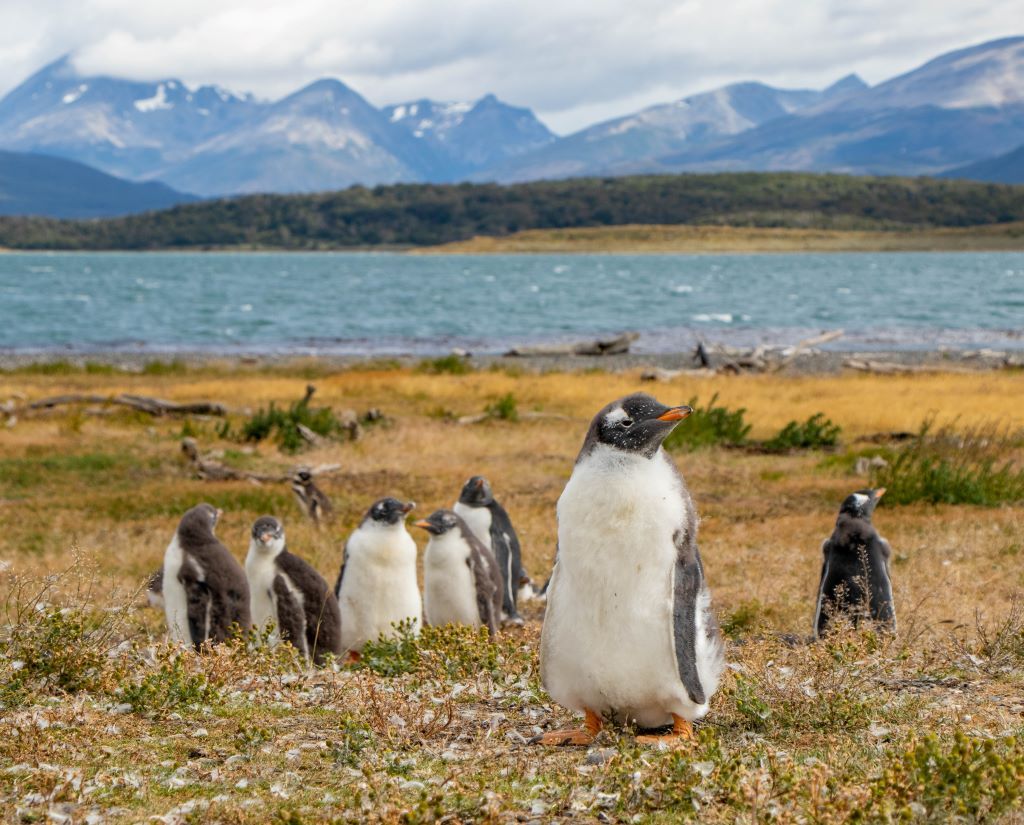
Birds
Andean condor is the Patagonian king in the sky. This impressively large bird has a wingspan of up to 3 metres which makes it one of the largest flying birds in the world. It nests at high altitudes of up to 5000 m and lays only one or two eggs. Some condors in captivity have lived for more than 70 years! They feed mostly on carrion, such as carcasses of deer.
Andean condor is one of the symbols of Patagonia and it can be found on Chiles’ coat-of-arms alongside huemul deer.

Darwin’s rhea or lesser rhea is a large Patagonian land bird that can be found in the steppe regions of Patagonia. It can’t fly but it sure can run! Rhea can reach speeds of up to 40 km/h, which protects them from most predators. They usually live in groups of 20 to 30 birds and feed mostly on grass and fruits, with occasional insects or lizards.
The Chilean flamingo is a species of flamingo inhabiting the salt lagoons of Patagonia. Normally, flamingos are found in warmer areas, but Chilean flamingos have their home in the salty waters of chilly Patagonia. Flamingos in general are characterized by their long, thin legs and pale pink plumage. While the Chilean flamingo is specific for its grey legs and black beak.
What to do in Patagonia
Patagonia is a real paradise for outdoor activities and nature lovers. Pristine lakes for fishing, rivers to kayak on, numerous glaciers to explore, and plenty of mountains to hike. The list of things you could do in Patagonia is quite extensive, so we will try to keep it short and sweet.
Hiking
The whole region is renowned for its wide variety of treks you can hike. From famous W and O circuits in Torres del Paine and Laguna de Los Tres on Fitz Roy to the lesser-known treks such as Cerro Castillo Traverse. Wherever you choose to go in Patagonia we are sure that you will find a hiking trek that suits you.

Kayaking
Have you ever tried kayaking between fjords and glaciers? If you haven’t, here is your opportunity. All the Chiles’ coast is a true delight for kayaking. Those who are the bravest can go for a kayaking excursion from Bernand O’higgins national park all the way south to Tierra del Fuego national park.
Skiing
Snow is probably not the first thing you think of in South America. However, the Andes offer plenty of skiing resorts for winter sports activities.
Without a doubt, the best ski resort in Patagonia is Cerro Catedral Alta Patagonia near Bariloche. At Catedral, there are 120 km of slopes and 10 km of ski routes which are serviced by 38 ski lifts.
Cerro Castro is a great skiing resort in Tierra del Fuego, near Ushuaia. At Cerro Castro, there is 29 km of slopes available for skiing and snowboarding.
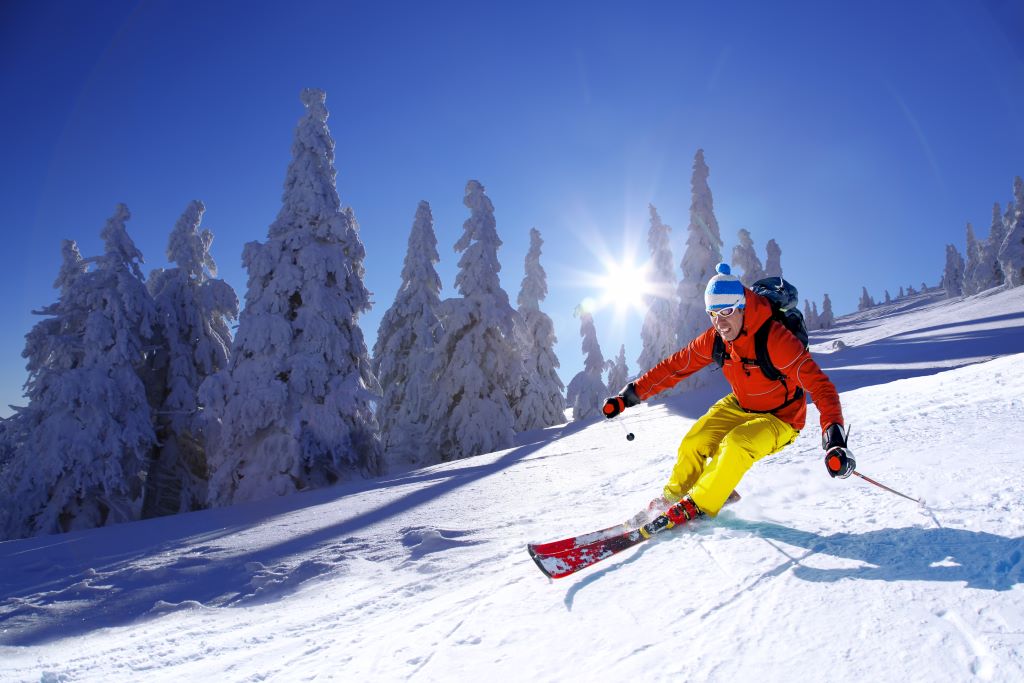
Fly fishing
In the past, fly fishing was an activity for true lovers and hobbyists. Nowadays there are many agencies offering fishing trips and tours on Patagonian waters. Patagonia is really hard to match when it comes to fish diversity and the quality of the water.
You can find different types of Patagonian Salmon and Trout in the waters of Patagonia. Brown Trout, Rainbow trout, Steelhead trout, King salmon and Coho salmon to name a few. Among the best places to try your luck with fishing are Rio Grande, Rio Pico, Futaleufú and Tierra del Fuego.
Cruising
Taking a boat trip through Chilean fjords is another popular activity in Patagonia. There is a wide variety of cruises offered, some are single-day while others last for more than 20 days. The toughest and most challenging is the cruise from Patagonia to Antarctica. The 7th continent is only 1000 kilometres from Cape Horn, but the journey there is nothing short of spectacular.
Horseback riding
Horse riding is a vital part of Patagonian tradition and culture. Gauchos are world-famous nomadic horsemen originating from Argentinian pampas. They are folk-symbol often admired in legends, folklore, and literature.
They are not as popular as they used to be, however, being a gaucho is still a respectable profession. Part of their culture is providing horseback excursions and educating tourists about their rich traditions.
Photographing
Patagonia has gained a reputation for being a heaven for photographers. Many picturesque locations are just begging for the camera objective to take a photo. Besides nature and wildlife photography, Patagonian stars are also quite popular among photographers. Autumn is especially beautiful because of the wonderful colours of the trees.
Cycling
Riding a bike through the astonishing landscape of Patagonia is quite enjoyable but also challenging. When it comes to bicycle routes, two of them stand out.
Carretera Austral or Chile’s Ruta 7 is a 1247 km long stretch from Puerto Montt to Villa O’Higgins. Ruta 40 is an epic 5000km road that cuts vertically through the Argentine side of Patagonia from Bariloche to Rio Gallegos.
These legendary routes include wonderful scenery of mountains, volcanos, forests, national parks and much more.
Food and drinks in Patagonia
Chilean and Argentinian cuisine both have a good reputation around the world. For this reason, Patagonia cuisine should be a delight for taste buds, and it is. Strongly influenced by Europeans, the traditional recipes of Patagonia resemble those of European ancestors but with unique ingredients and flavours. Unsurprisingly, meat seems to be the staple in most dishes. However, there are also plenty of seafood dishes you can try. To round it all up, you should taste some local wine or beer accompanied by a delicious dessert.
Here is a list of a few noteworthy dishes you should try while visiting Patagonia.
Asado
We have to start the list with the national dish of Argentina. Asado is an Argentine-style barbecue, and Argentinians love their barbecue! All kinds of local meat are cooked over the open fire of Asado. When we say all kinds of meat, we mean all kinds of meat. Beef, lamb, pork, chicken, and even guanaco meat, you name it, they will barbecue it.
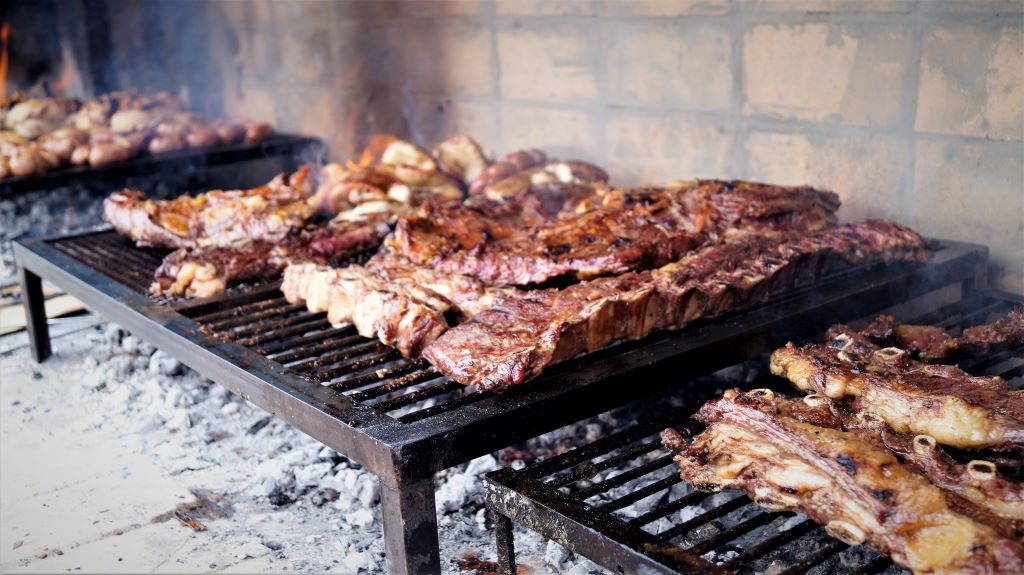
Cordero al Palo
Spit Roast Lamb is the most famous Patagonian dish. The lamb is cooked on a metal cross over an open fire for several hours. This results in wonderfully delicious, crispy meat that falls off the bone like butter. Certainly one of the dishes you have to try while in Patagonia.
Chupa de Centolla
If you had enough meat for now, then you should try Patagonian King Crab Pie. Chupa de Centolla is a tasty stew made out of Patagonian King crab mixed with breadcrumbs which gives it a unique, creamy texture. Most of the time gratinated cheese is added on top for a delightful mixture of flavours!
Empanadas de Cordero
Empanada is a traditional Argentine dish of Spanish origin consisting of baked dough and filling of choice. Each Argentine region has its own unique mix, and Empanadas de Cordero is the Patagonian version. Empanadas de Cordero differs from other versions because they are filled with very thick roasted lamb stew, instead of the usual meat or cheese.
Chilean Sea bass
What is marketed as a Chilean Sea bass is actually Antarctica or Patagonian toothfish in most restaurants. The reason for this is the overfishing of an actual Chilean Sea bass which is now illegal. However, don’t let this stop you from trying Chilean Sea bass because it’s a really tasty and healthy dish nonetheless.
Vino
Both Argentina and Chile are among the top 10 wine-producing countries in the world. For this reason, the list would be incomplete without including wine. As with the cuisine, the Patagonian ‘vino’ also carries the tradition of European ancestors, primarily French and Spanish winemakers. Consequently, the main wine varieties in this region are red Pinot Noir, Merlot and Malbec. However, white Chardonnay and Sauvignon Blanc are also grown in the area.

Cervezas Artesanales
While wine is the go-to drink, craft beers have gained a lot of popularity in recent years and one town is leading the revolution. Bariloche is a city with the largest number of breweries per capita in Argentina. The reason for this is its unique location next to the largest hop-producing area in the country and plenty of pure water sources. Finding a good local craft beer throughout the region shouldn’t be a problem as they are available in bars, restaurants and hiking ‘refugios’.
Dulce de Leche
To round out our food & drinks list, we have a staple ingredient of many Patagonian desserts. Dulce de Leche, which translates to “sweet of milk” is prepared by slowly heating milk and sugar for several hours. The result is sweetened and condensed milk which is used in many recipes. Some of the best desserts that use Dulche de Leche are Alfajores, Dulce de Leche Brownies and Tres Leches Cake with Dulce de Leche.
Fun facts about Patagonia
Patagonia is a fascinating region with an incredibly rich history. From dinosaurs to pop culture, Patagonia has seen it all. In order to describe some of its uniqueness, we have made a summary of the interesting facts about Patagonia.
Patagonian dinosaurs
Did you know that Patagonia is full of dinosaur fossils? Patagonia is without a doubt one of the most important palaeontology sites in the world. Many spectacular fossils are found throughout the area.
The remains of the largest recorded dinosaur Argentinosaurus huinculensis have been found near the small city of Plaza Huincul. They are exhibited in Carmen Funes Museum in the city. This giant dinosaur is estimated to be from 35 to 45 metres!
Dinosaur lovers should also visit the Museum of Paleontology Egidio Feruglio in Trelew city.
Patagonian giants
According to the famous Portuguese explorer Ferdinand Magellan, dinosaurs were not the only giants to inhabit Patagonia. When he first came to the region, Magellan encountered native Patagonian people and claimed they were almost twice the size of a normal human! For this reason, he named the region “patagones” or “land of big feet”.
It was later established that Tehuelche people are not actual giants, but only a few feet taller than average Europeans. However, the myth has spread around and the name Patagonia stuck.
Patagonian Welsh
During the 1800s, around 150 Welsh people sailed to South America in search of a better life. They settled in the Chubut region of Argentina and despite many hardships, they managed to protect their language and culture. Over time, a new Welsh dialect called Patagonian Welsh has developed and flourished. Today more than 5000 people speak this language.
The Kingdom of Araucanía and Patagonia
Patagonia used to be an independent kingdom! Well, at least if you ask Antoine de Tounens. In 1858, this French lawyer read La Araucana, a 16th-century epic poem about the Spanish Conquest of Chile by Alonso de Ercilla. After reading the book, Tounens decided to go to Araucania and become its king.
In November 1860, he proclaimed the sovereignty of Araucania and eastern Patagonia and established himself as a monarch under the name King Orélie-Antoine I. He even created the flag and had the coins minted for his new kingdom.
Two years later, in January 1862 he was arrested by Chilean authorities, declared insane and expelled to France. Later on, he unsuccessfully tried to return to Araucania and reclaim his kingdom.
Patagonia in popular culture
With its jaw-dropping nature, it is no surprise that Patagonia was an inspiration to many writers, moviemakers and even entrepreneurs.
In Patagonia is a critically acclaimed 1977 travel book by Bruce Chatwin inspired by his journey to Patagonia.
The Old Patagonian Express (1979) is a book describing the journey of novelist Paul Theroux. He travelled by train from his hometown in Massachusetts all the way to Esquel in Patagonia.
Patagonia is a name of a popular brand of clothing created by Yvon Chouinard, an accomplished rock climber.
Patagonia (film) is a 2010 Welsh-Argentine drama film featuring well-known Welsh actors including Matthew Rhys and singer Duffy. It was nominated as the British entry for Best Foreign language film at the 84th Academy Awards.
Accommodation in Patagonia
Tourist infrastructure in Patagonia holds a high standard, unlike in some other parts of the continent. There is a variety of accommodations ranging from luxury hotels to mountain cabins and camping sites. If you are coming during the high season from December to March, we advise you to book your accommodation in advance because it gets crowded.
Hostels and hotels are in tourist towns such as Bariloche, Ushuaia, El Chalten, and Puerto Natales. There are some world-class luxury hotels in the region that will satisfy even the toughest judges. Those on the budget will have plenty of options as well.
Estancias are authentic Patagonian experiences. They are tied to the ranches in the Argentine steppe and Gauchos. Usually, they are family-run and offer activities such as horseback riding and fishing.
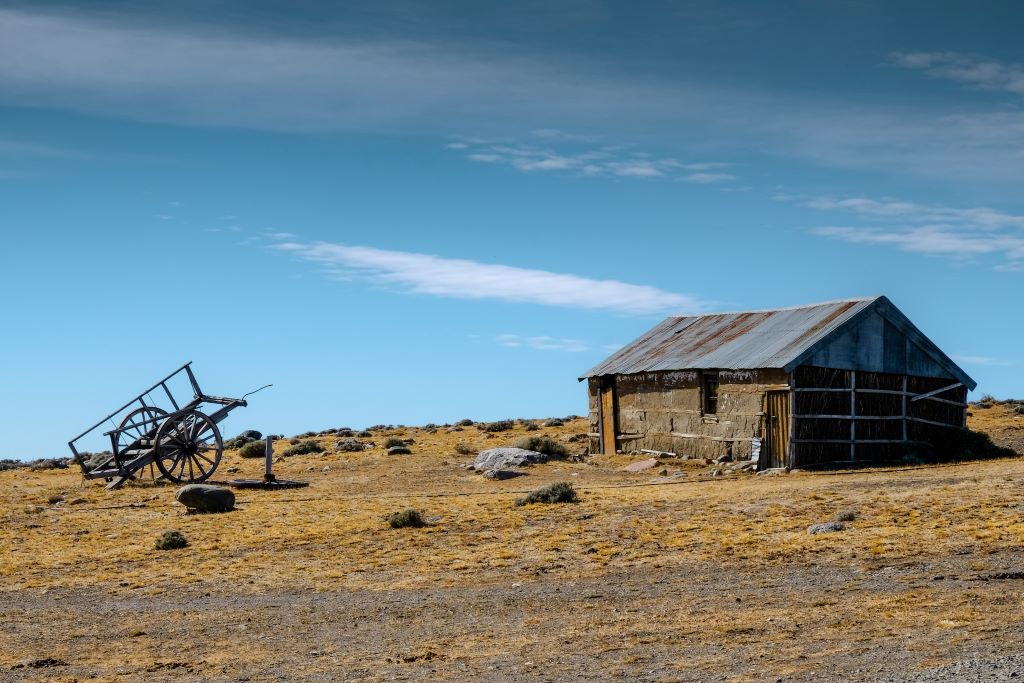
Refugios are mountain huts located in national parks of Patagonia such as Torres Del Paine. They are not cheap but certainly help during the multi-day hiking routes. You will find restaurants and small shops near refugios.
Cabanas or cabins are located mostly in Chile. In general, they offer good value for money. Most of them have a kitchen and more privacy than refugios or camping sites.
Camping is very popular and spread throughout Patagonia. Camping sites are usually equipped with hot showers and some basic facilities. They get really crowded during the tourist season so bringing your own tent is a good idea.
Residenciales and Pensiones are Patagonian equivalent of B&B. They are relatively affordable accommodations. Most of them have private toilets and showers. The kitchen is usually shared.





